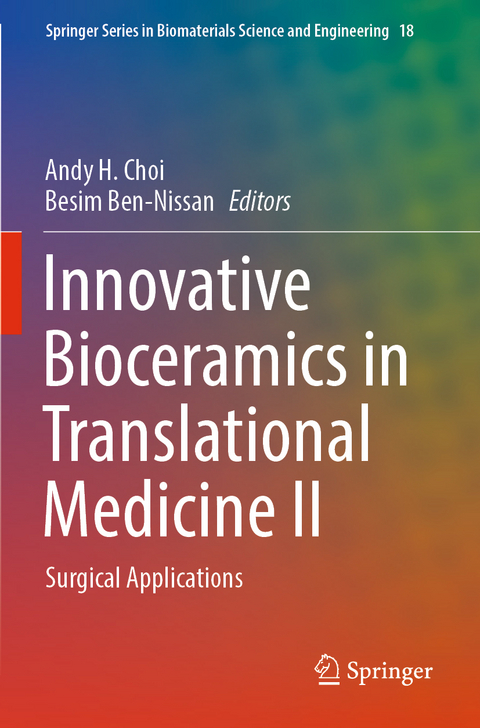
Innovative Bioceramics in Translational Medicine II
Springer Verlag, Singapore
978-981-16-7441-9 (ISBN)
Dr. Andy H. Choi is an early career researcher who received his Ph.D. from the University of Technology Sydney (UTS) in Australia in 2004 on the use of computer modeling and simulation known as finite element analysis (FEA) to examine the biomechanical behavior of implants installed into a human mandible. After completing his Ph.D., he expanded his research focus from FEA to sol–gel synthesis of multifunctional calcium phosphate nano-coatings and nanocomposite coatings for dental and biomedical applications. He is currently serving as an associate editor for the Journal of the Australian Ceramic Society and as an editor for a number of dentistry-related journals. In addition, he is also serving as an editorial board member for several dentistry, nanotechnology, and orthopedics journals. To date, Dr. Choi has published over 50 publications including 3 books (Thin Films and Nanocoatings of Hydroxyapatite on Titanium Implants: Production Methods and Adhesion Testing [ISBN 978-3-330-06425-6]; Anatomy, Modeling and Biomaterial Fabrication for Dental and Maxillofacial Applications [eISBN: 978-1-68108-691-0, 2018; ISBN: 978-1-68108-692-7]; Marine-Derived Biomaterials for Tissue Engineering Applications [ISBN: ISBN: 978-981-13-8855-2) and 30 chapters on calcium phosphate, nano-biomaterial coatings, sol-gel technology, marine structures, drug delivery, tissue engineering, and finite element analysis in nanomedicine and dentistry. Professor Basim Ben-Nissan has higher degrees in Metallurgical and Materials Engineering (ITU), Ceramic Engineering (University of New South Wales) and a Ph.D. in Mechanical and Industrial Engineering–Biomedical Engineering (University of New South Wales). Over the last four decades together with a large numbers of Ph.D. students and postdoctoral fellows and surgeons, he has worked on production and analysis of various biomedical materials, implants, slow drug delivery devices, calcium phosphate ceramics,advanced ceramics (alumina, zirconia, silicon nitrides), sol–gel developed nanocoatings for enhanced bioactivity, antimicrobial coatings, corrosion and abrasion-resistant coatings, optical and electronic ceramics, and thermally insulating new generation composites. In the biomedical field, he has involved with the development of materials for antimicrobial drug delivery, stem cell research, cell culture studies and cytotoxicity, natural and marine derived materials, implant technology (bioactive materials including conversion of Australian corals to hydroxyapatite and other bone grafts), biomimetics (learning from nature and its application to regenerative medicine), bio-composites, investigative research on biomechanics and finite element analysis (mandible, knee, hip joints, hip resurfacing, femoral head stresses), and reliability and implant design (modular ceramic knee prosthesis, femoral head stresses). He was part of a research team which initiated the world’s first reliable ceramic knee and hydroxyapatite sol–gel-derived nanocoatings and recently bioprinting and proto-cell research. Since 1990, he has published over 270 papers in journals, 60 chapters, and edited and co-edited 7 books. He is the chief editor of the Journal of the Australian Ceramic Society and the editorial board member of three international biomaterials journals. He was awarded “The Australasian Ceramic Society Award” for his contribution to the “Ceramic Education and Research in Australia.” He also received “Future Materials Award” for his contribution in the “Advanced Nanocoated Materials.” He has collaborated with several international groups from Japan, USA, Thailand, Finland, Israel, France, UK, Germany, and Turkey and held grants from the Australian Academy of Science, European Commission-HORIZON2020 and the Japan Society for Promotion of Science grants for collaborative work in the biomedical field. After serving as an academic for over 33 years, he has retired from teaching, however, still is active and contributes to science by research in the translational medicine, biomedical field, and supervising of higher degree students.
Preface.- Past and Future of Wound Dressing in Soft and Hard Tissue Surgery.- 3D Printing and Bioprinting of Biomaterials and Bioceramic Scaffolds: Clinical Outcomes and Implications in Bone Tissue Engineering and Maxillofacial Reconstructive Surgery.- Bioresorbable Bone Fixation Devices for Oral and Maxillofacial Surgery.- Tissue Engineering Strategies for Craniomaxillofacial Surgery: Current Trends in 3D-Printed Bioactive Ceramic Scaffolds.- Clinical Applications of Monoclonal Antibodies: Key Technological Advances and Treatment of Osteoporosis.- Antibody Treatment and Osteoporosis: Clinical Perspective.- Fabrication of Fully Artificial Carbonate Apatite Bone Substitutes.- Smart Bioceramics for Orthopedic Applications.- Bone Morphogenic Proteins and Bioceramic Scaffolds in Orthopedics.- Spine Surgery - Part I: Biomechanics, Materials, and 3-D Printing Technology: Surgical Perspective and Clinical Impact.- Spine Surgery - Part II: Ceramic and Non-Ceramic Bone Substitutes: A Surgical Perspective.- Orthopedic Application of Collagen-Hydroxyapatite Bone Substitutes: A Clinical Perspective.
| Erscheinungsdatum | 24.12.2022 |
|---|---|
| Reihe/Serie | Springer Series in Biomaterials Science and Engineering ; 18 |
| Zusatzinfo | 92 Illustrations, color; 15 Illustrations, black and white; XVI, 269 p. 107 illus., 92 illus. in color. |
| Verlagsort | Singapore |
| Sprache | englisch |
| Maße | 155 x 235 mm |
| Themenwelt | Medizin / Pharmazie ► Physiotherapie / Ergotherapie ► Orthopädie |
| Naturwissenschaften ► Chemie | |
| Technik ► Maschinenbau | |
| Technik ► Medizintechnik | |
| ISBN-10 | 981-16-7441-8 / 9811674418 |
| ISBN-13 | 978-981-16-7441-9 / 9789811674419 |
| Zustand | Neuware |
| Haben Sie eine Frage zum Produkt? |
aus dem Bereich


